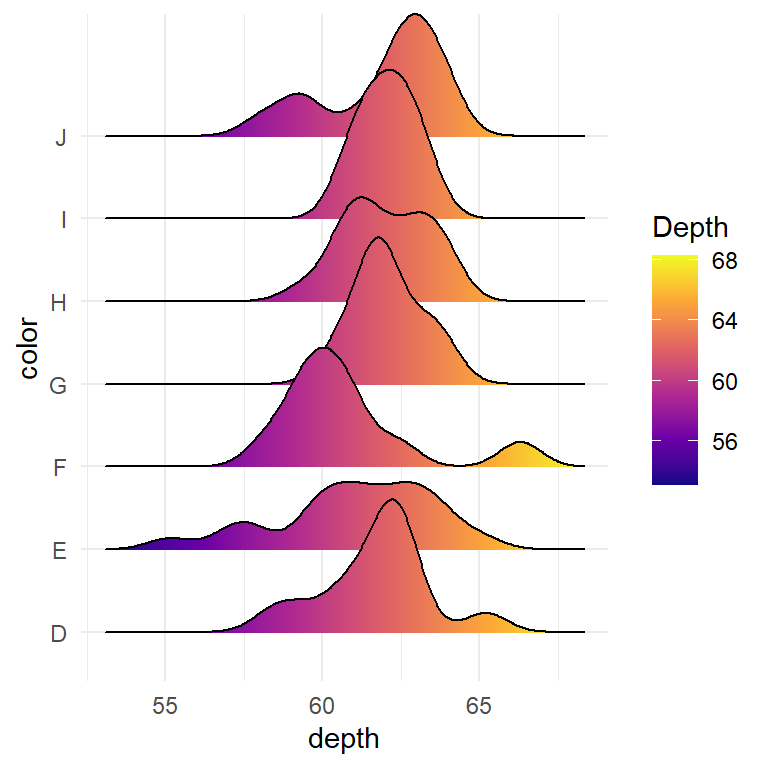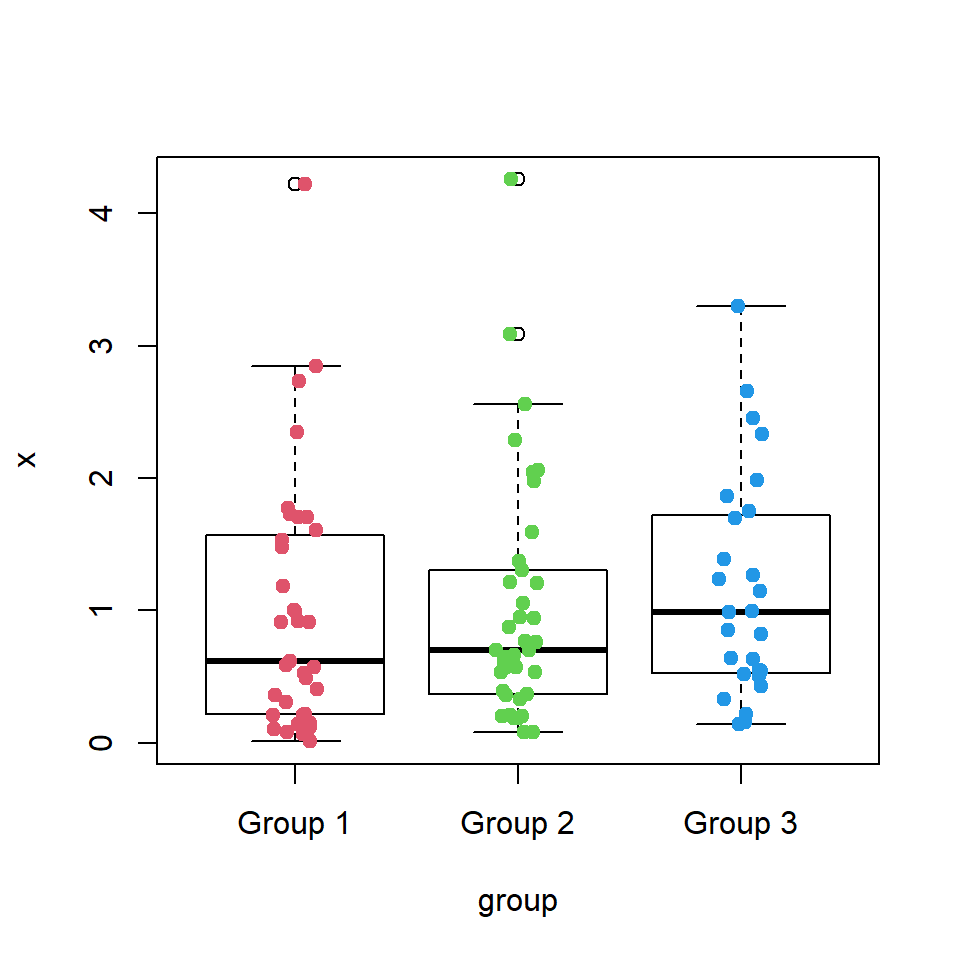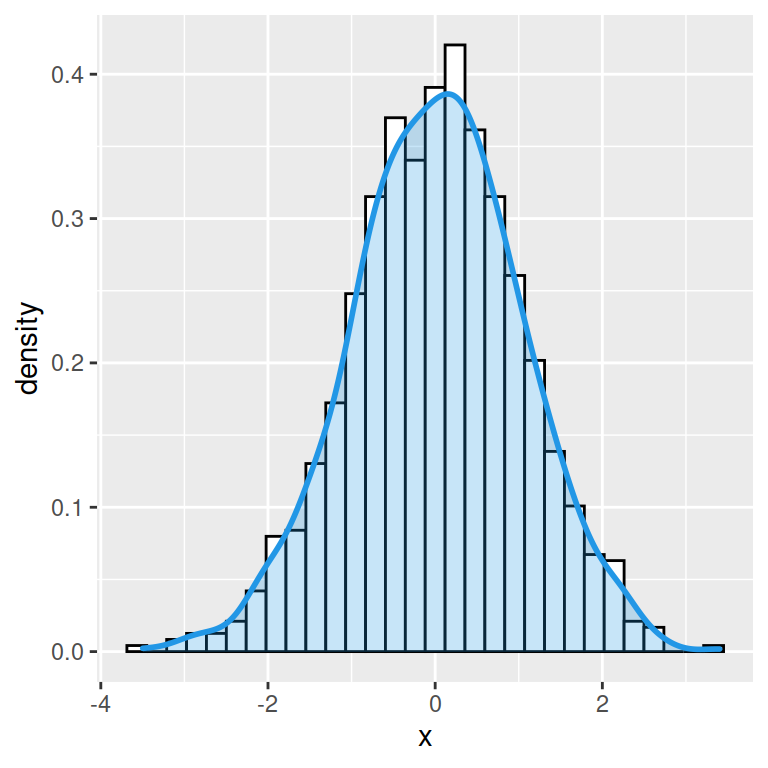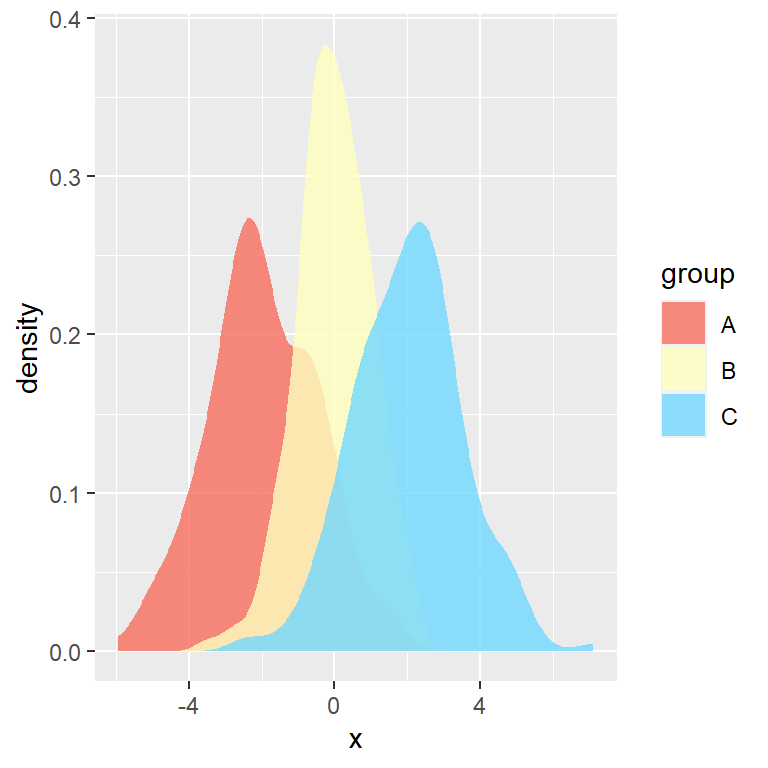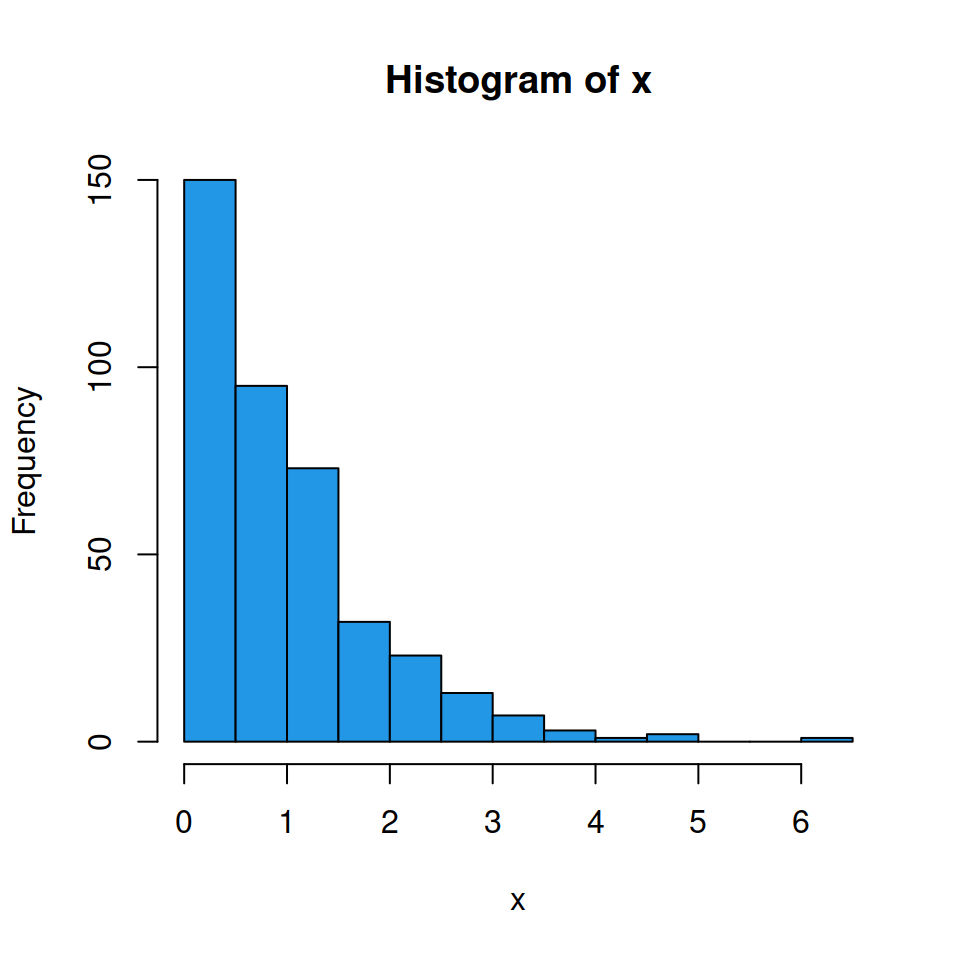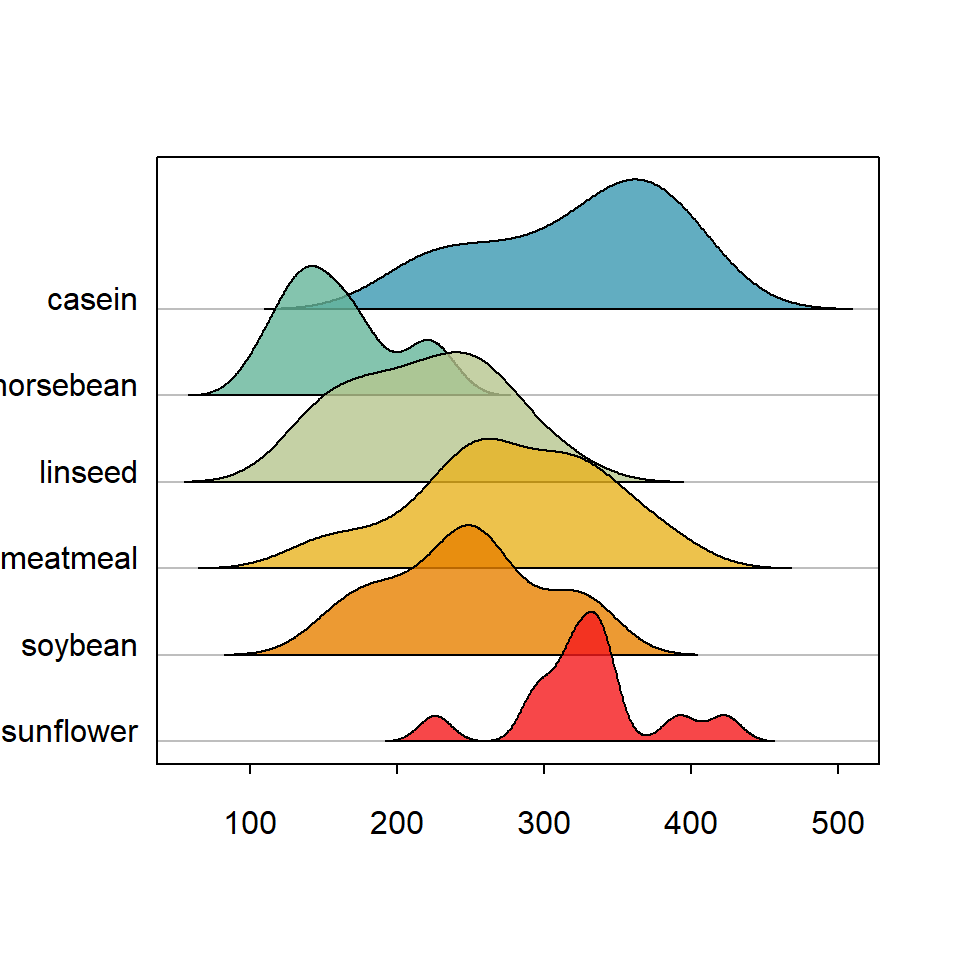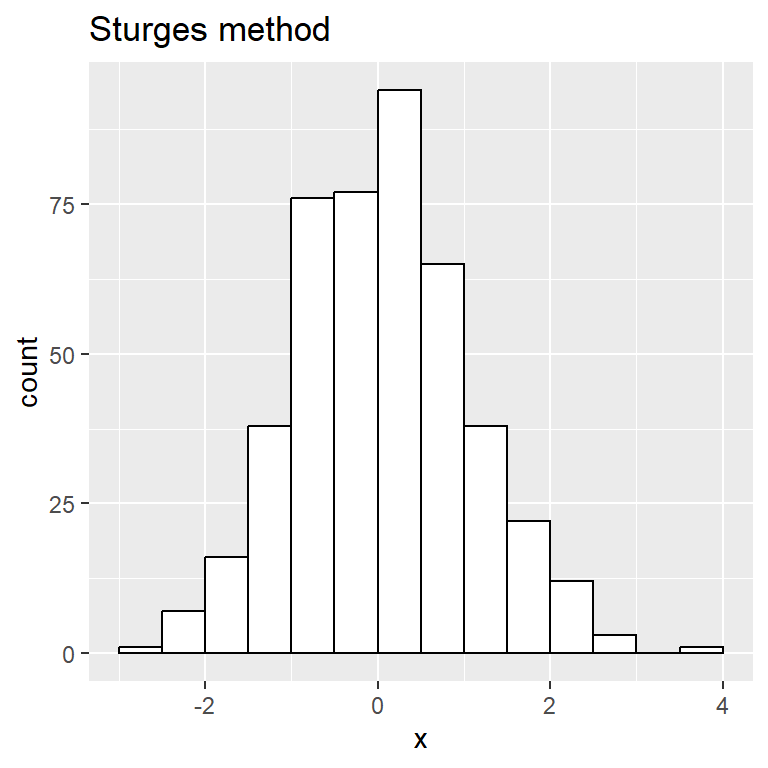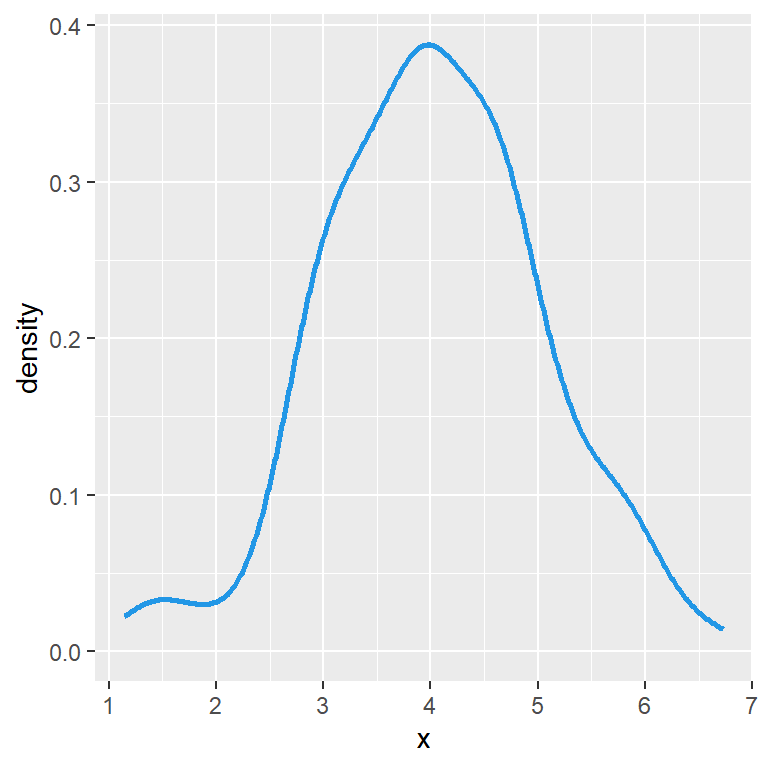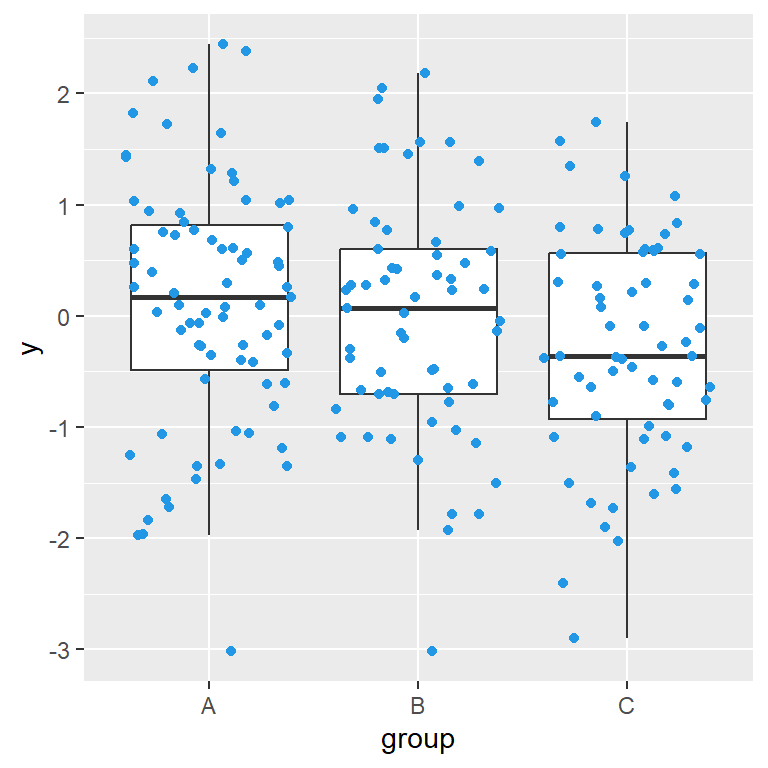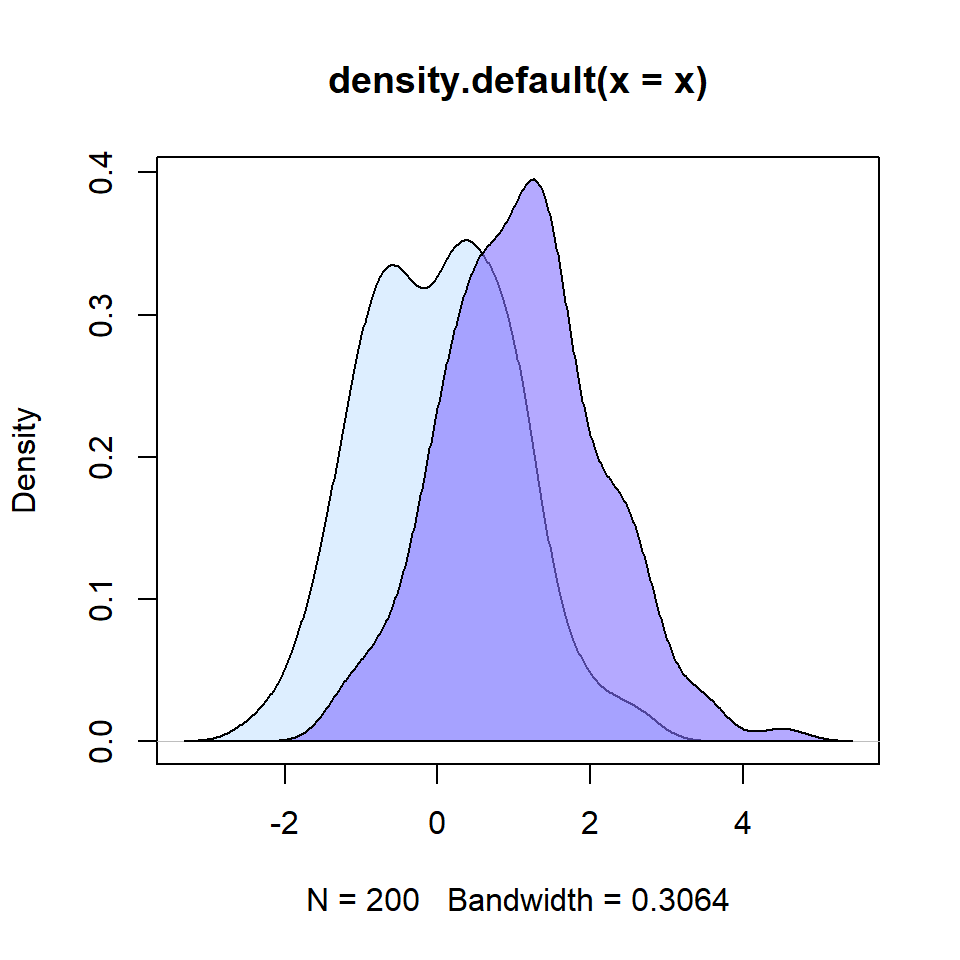Bee swarm plots are similar to strip charts and are designed to show the underlying distribution of the data but unlike strip charts, the data is arranged in a way that avoids overlapping.
Basic beeswarm plot
The R beeswarm package contains a function of the same name that allows creating this type of plot. You need to input a numeric vector, a data frame or a list of numeric vectors.
# install.packages("beeswarm")
library(beeswarm)
# Data generation
set.seed(1995)
x <- rnorm(300)
# Bee swarm plot
beeswarm(x)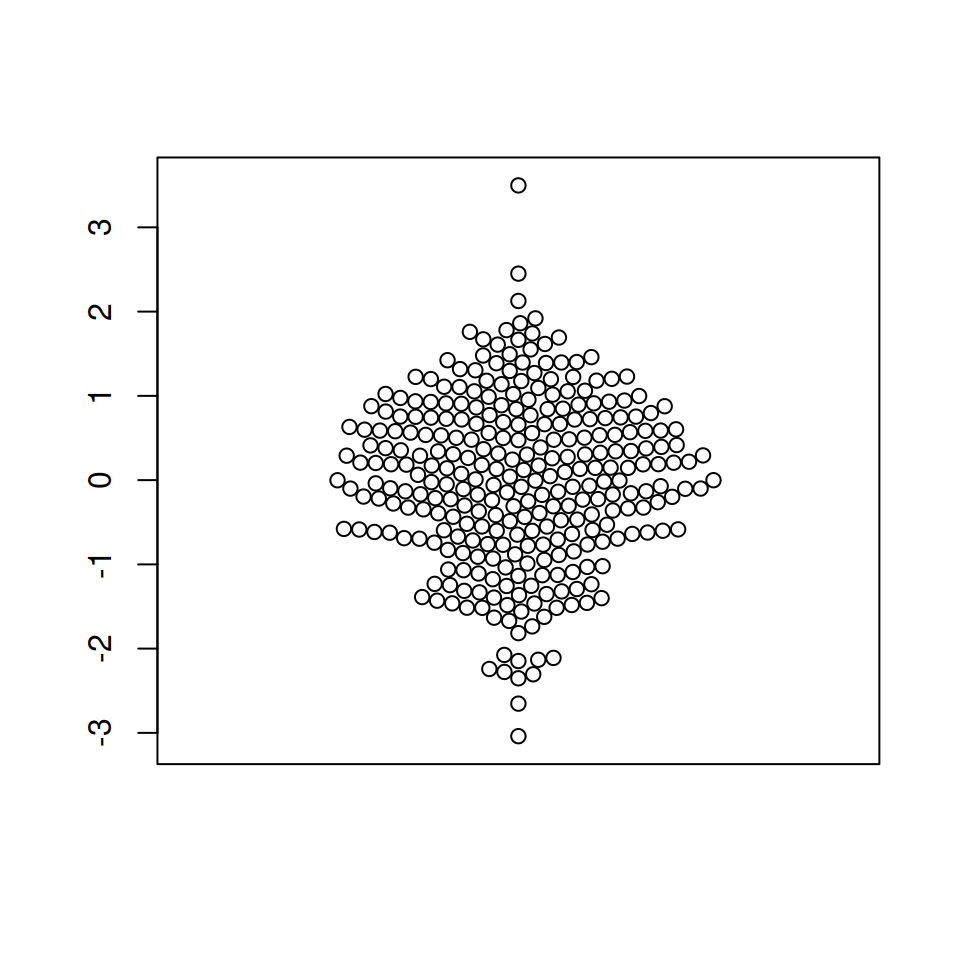
The plot can be customized the same way as other base R plots. Change the color of the points, the symbol and its size with col, pch and cex, respectively.
# install.packages("beeswarm")
library(beeswarm)
# Data generation
set.seed(1995)
x <- rnorm(300)
# Bee swarm plot
beeswarm(x,
col = 2, # Color
pch = 18, # Symbol
cex = 1.5) # Size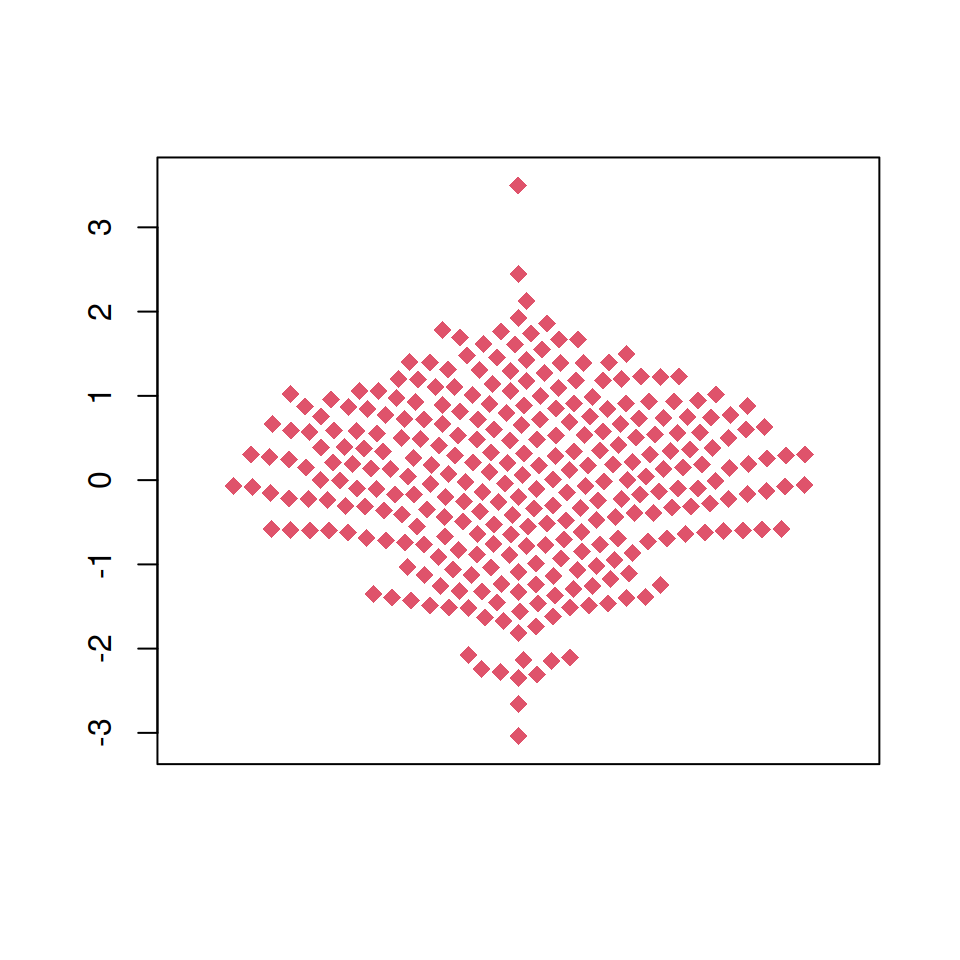
The plot can also be created in horizontal mode, setting vertical = FALSE or horizontal = TRUE.
# install.packages("beeswarm")
library(beeswarm)
# Data generation
set.seed(1995)
x <- rnorm(300)
# Horizontal bee swarm plot
beeswarm(x, col = 4,
vertical = FALSE) # Or horizontal = TRUE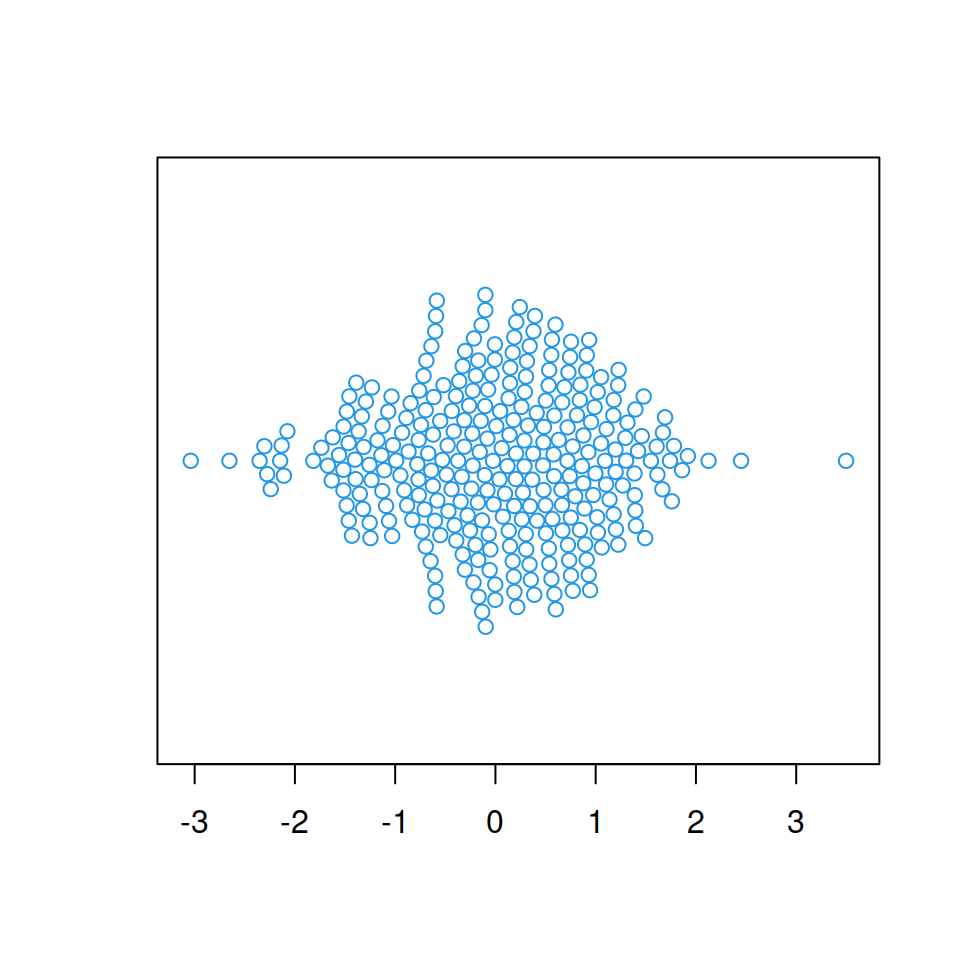
Beeswarm by group
If you have a categorical variable representing groups it is possible to create a bee swarm plot by group based on the levels of that variable. For that purpose pass a formula to the function with the corresponding variables.
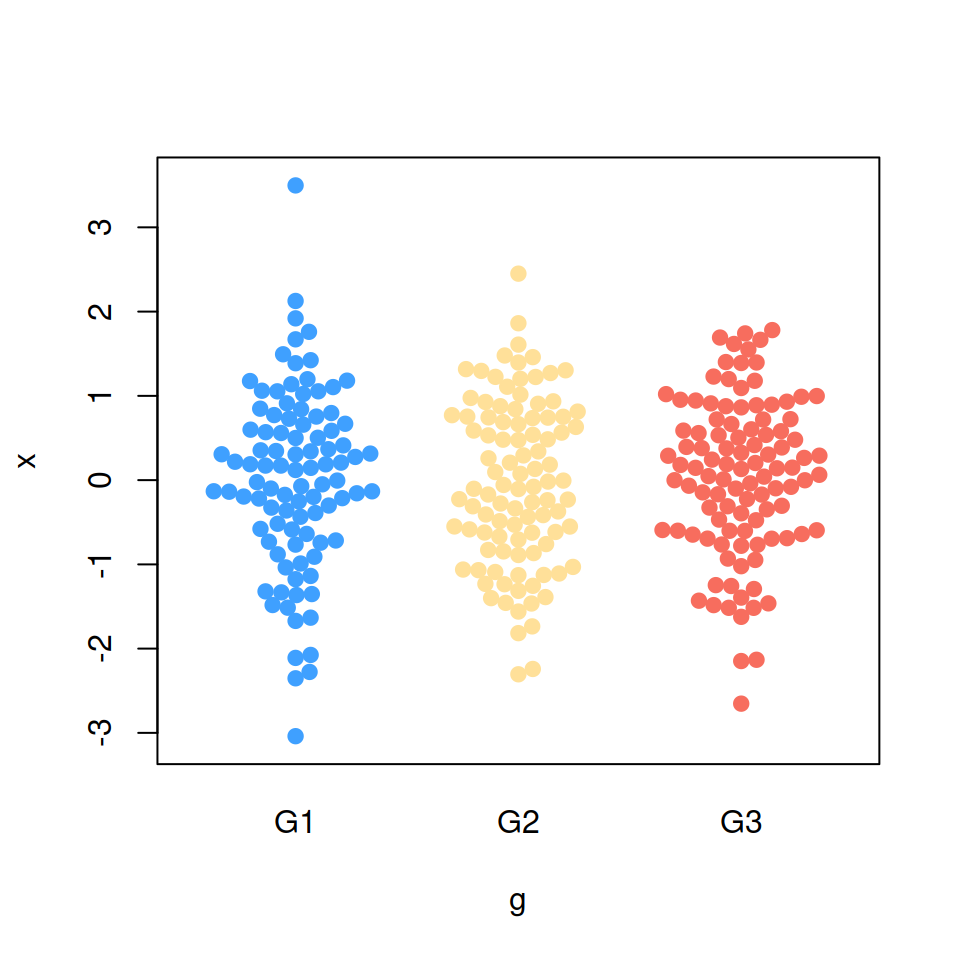
# install.packages("beeswarm")
library(beeswarm)
# Data generation
set.seed(1995)
x <- rnorm(300)
g <- sample(c("G1", "G2", "G3"),
size = 300, replace = TRUE)
# Bee swarm plot by group
beeswarm(x ~ g,
pch = 19,
col = c("#3FA0FF", "#FFE099", "#F76D5E"))If you have another categorical variable which represents some subgroups inside the main groups you can color each bee swarm with different colors representing that subcategories. Use the pwcol argument to indicate the colors. Alternatively, you can set the pch symbols with pwpch.
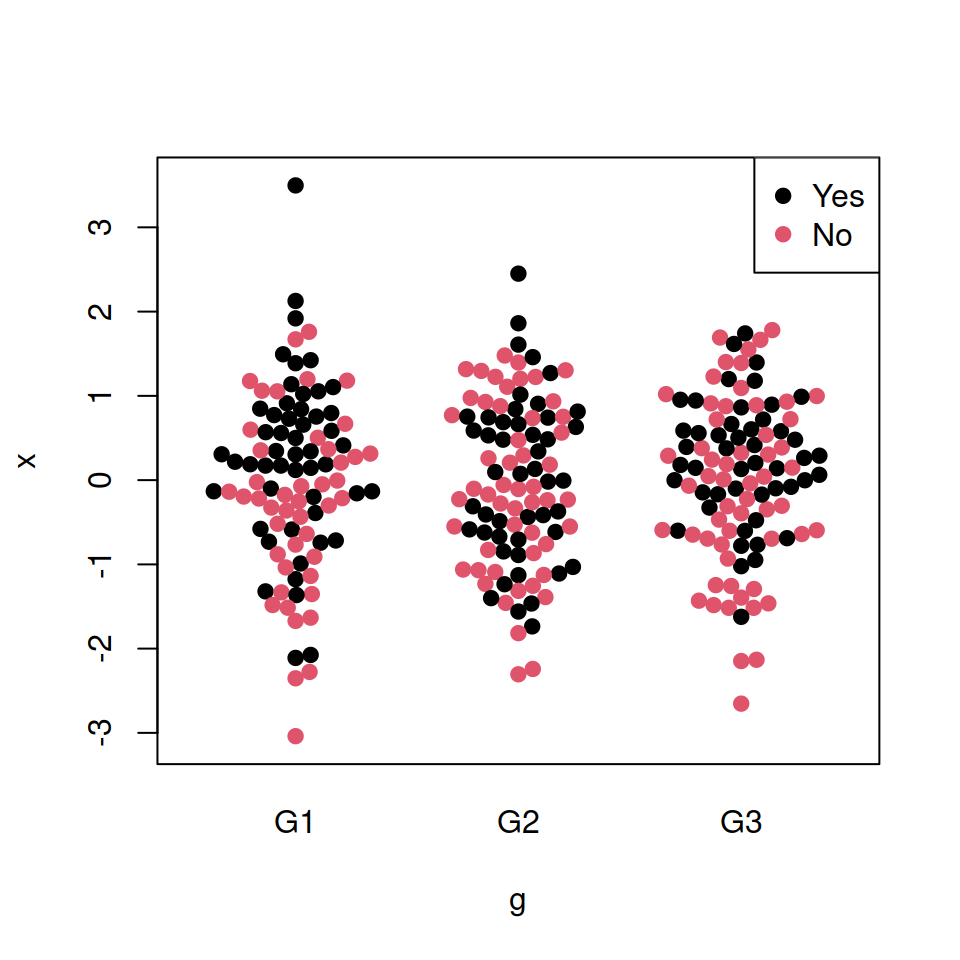
# install.packages("beeswarm")
library(beeswarm)
# Data generation
set.seed(1995)
x <- rnorm(300)
g <- sample(c("G1", "G2", "G3"),
size = 300, replace = TRUE)
z <- as.numeric(factor(sample(c("Yes", "No"),
size = 300, replace = TRUE)))
# Bee swarm plot by group
beeswarm(x ~ g,
pch = 19,
pwcol = as.numeric(z))
# Legend
legend("topright", legend = c("Yes", "No"),
col = 1:2, pch = 19)Bee swarm plot methods
There are several methods available for arranging the data points. Each method uses a different algorithm ensuring that the data points are not overlapped.
“swarm” method (default)
This method places the points in increasing order.
# install.packages("beeswarm")
library(beeswarm)
# Data generation
set.seed(1995)
x <- rnorm(300)
# swarm method
beeswarm(x, col = 4, pch = 19,
method = "swarm")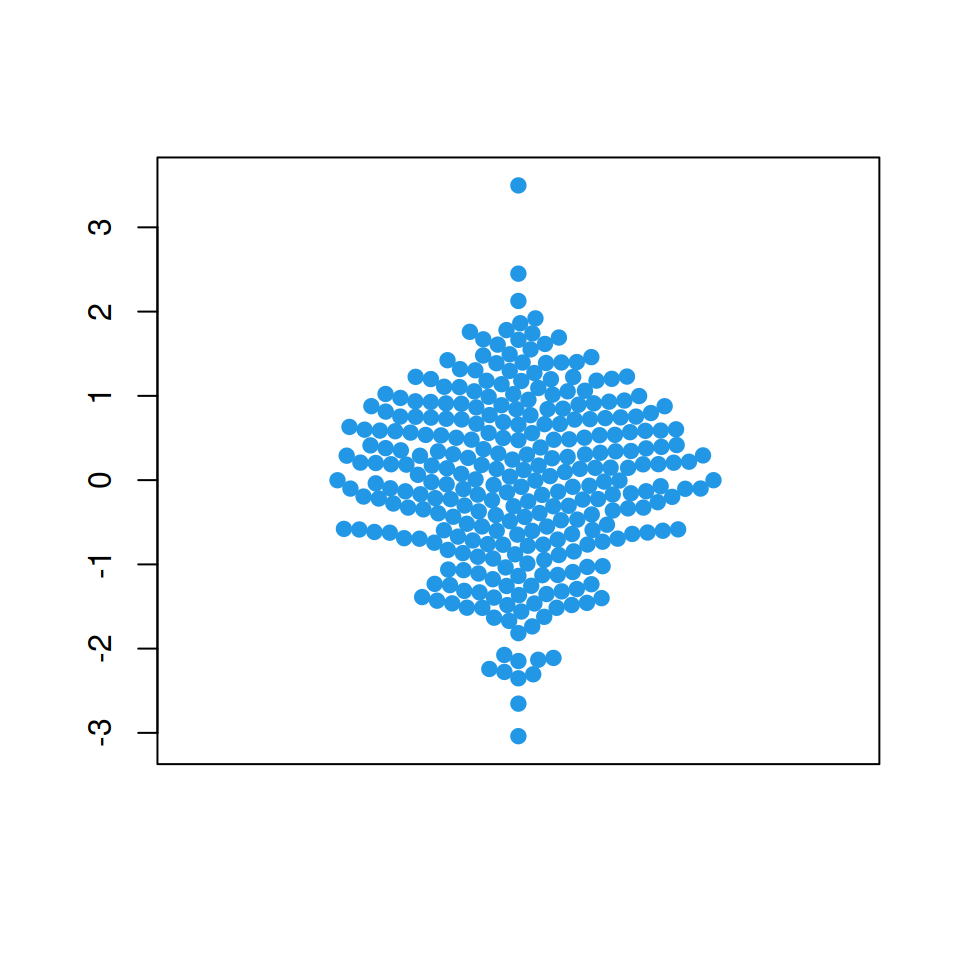
“center” method
The center method creates a symmetric swarm using a square grid.
# install.packages("beeswarm")
library(beeswarm)
# Data generation
set.seed(1995)
x <- rnorm(300)
# center method
beeswarm(x, col = 4, pch = 19,
method = "center")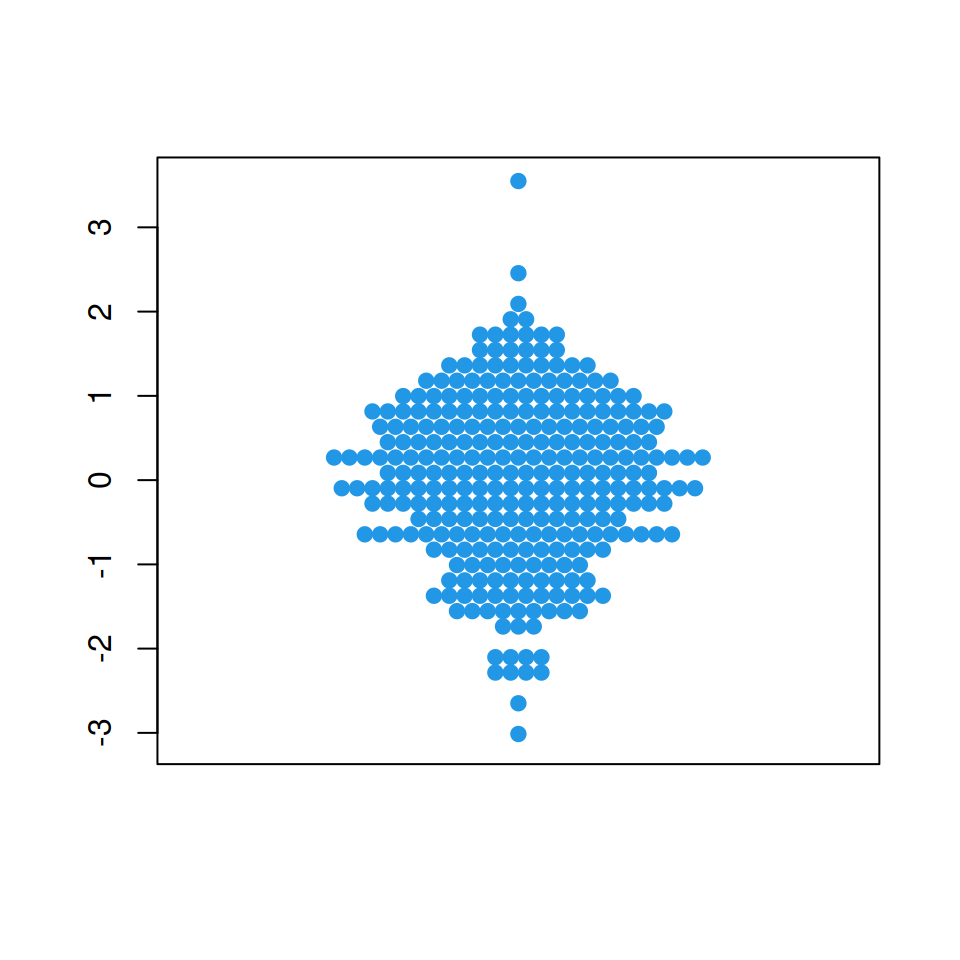
“hex” method
This method uses a hexagonal grid to place the data points.
# install.packages("beeswarm")
library(beeswarm)
# Data generation
set.seed(1995)
x <- rnorm(300)
# hex method
beeswarm(x, col = 4, pch = 19,
method = "hex")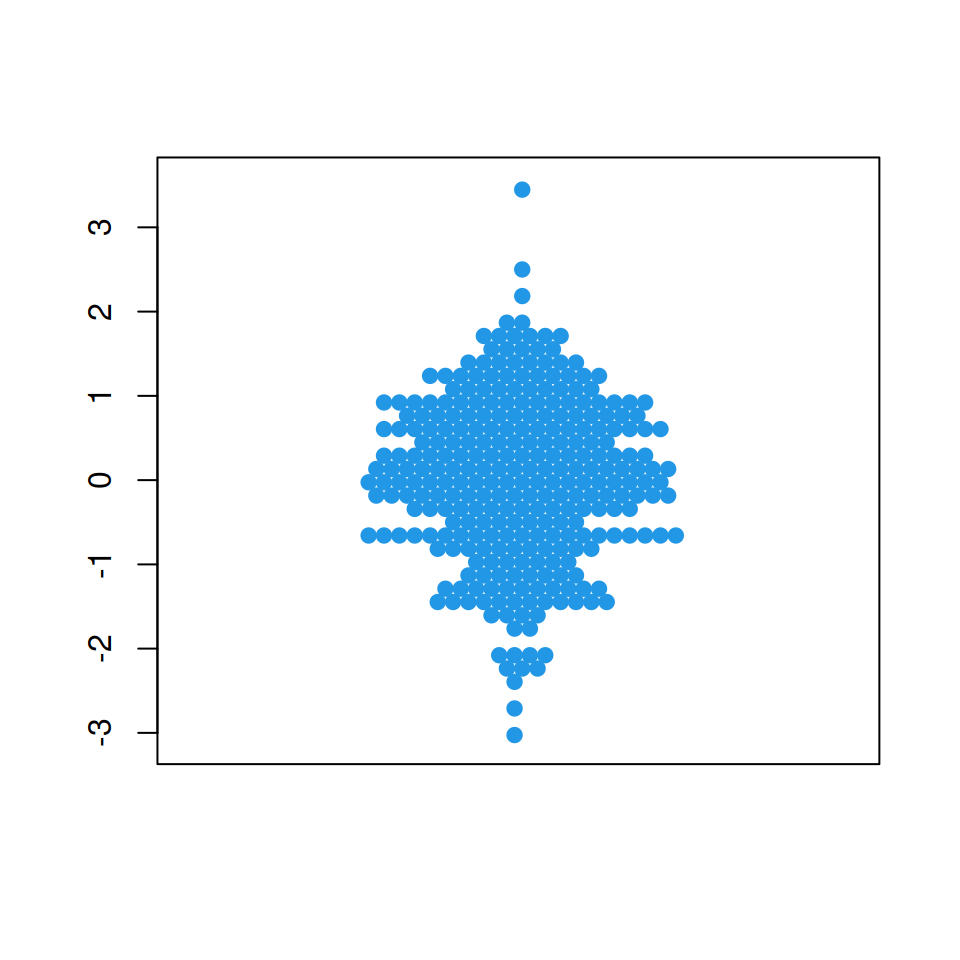
“square” method
The square method place the data points on a square grid.
# install.packages("beeswarm")
library(beeswarm)
# Data generation
set.seed(1995)
x <- rnorm(300)
# square method
beeswarm(x, col = 4, pch = 19,
method = "square")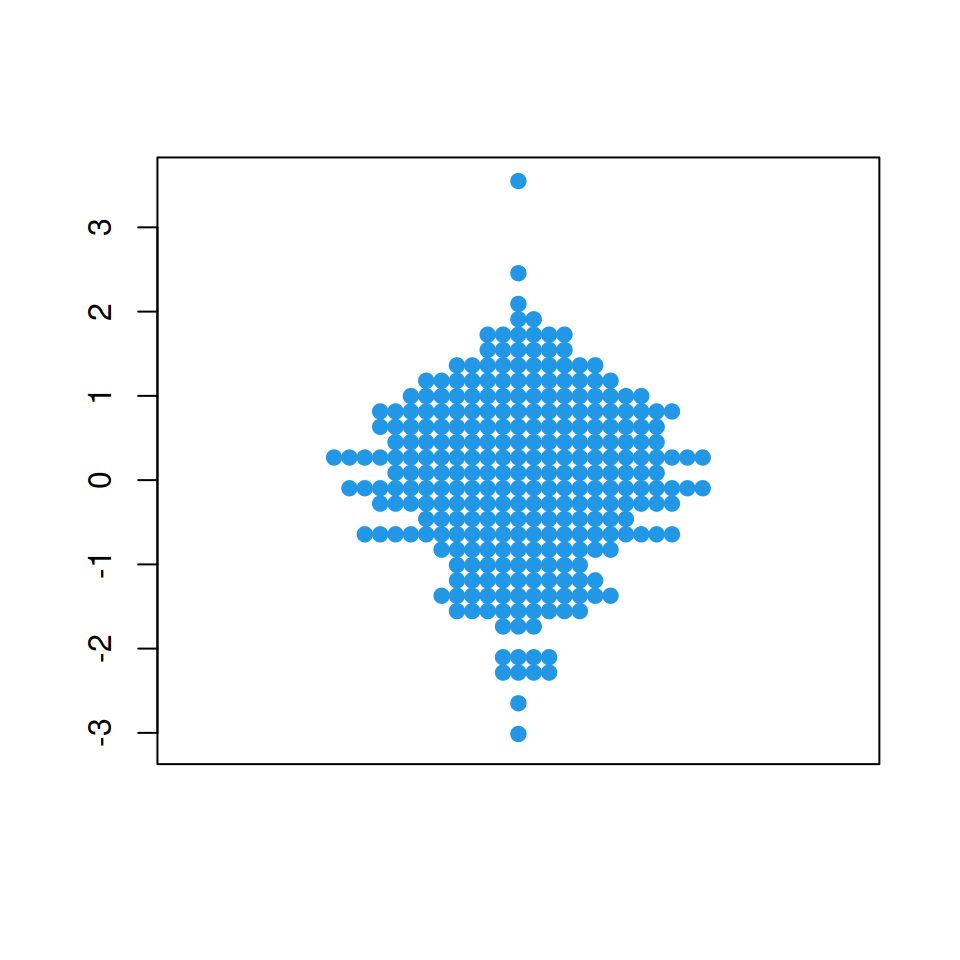
Bee swarm corral methods
If some observations are placed outside the plot area you can use a “corral” method, which will adjust that data points accordingly to the selected method.
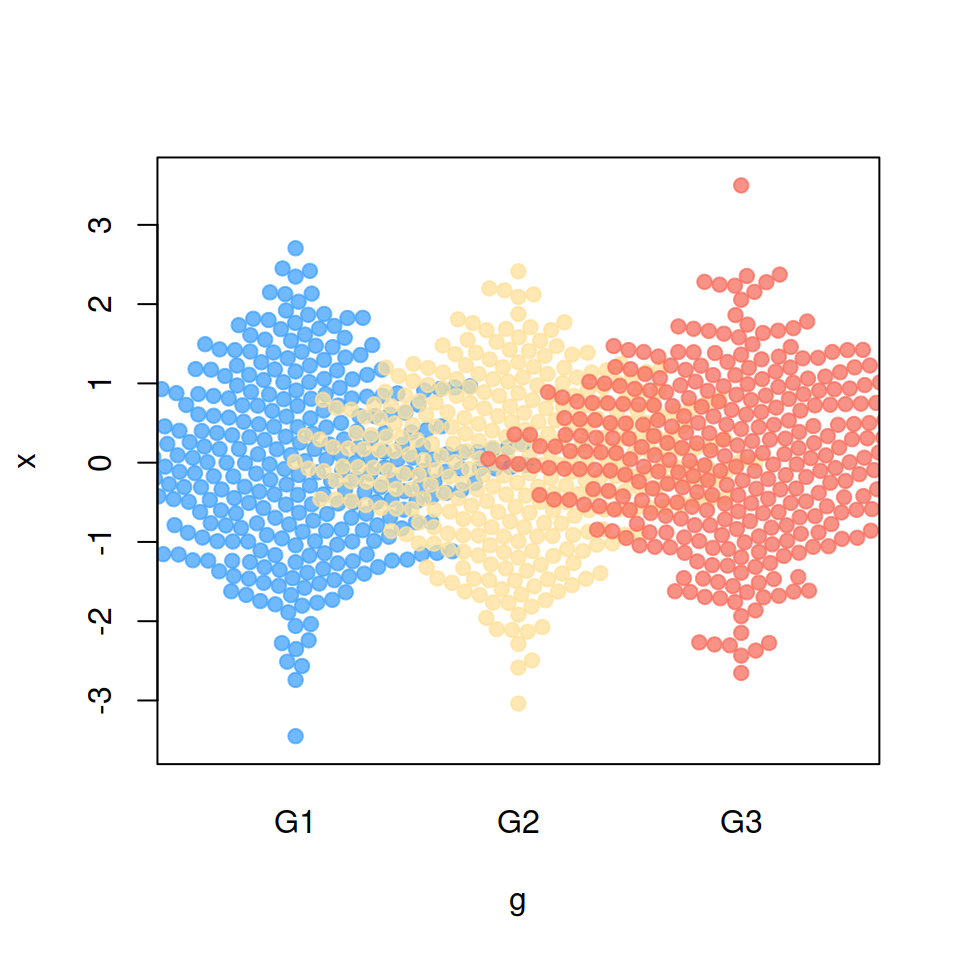
Default
# install.packages("beeswarm")
library(beeswarm)
# Data generation
set.seed(1995)
x <- rnorm(1000)
g <- sample(c("G1", "G2", "G3"),
size = 1000, replace = TRUE)
# Bee swarm plot by group
beeswarm(x ~ g, pch = 19,
col = c(rgb(0.25, 0.63, 1, 0.75),
rgb(1, 0.88, 0.6, 0.75),
rgb(0.97, 0.43, 0.37, 0.75)),
corral = "none")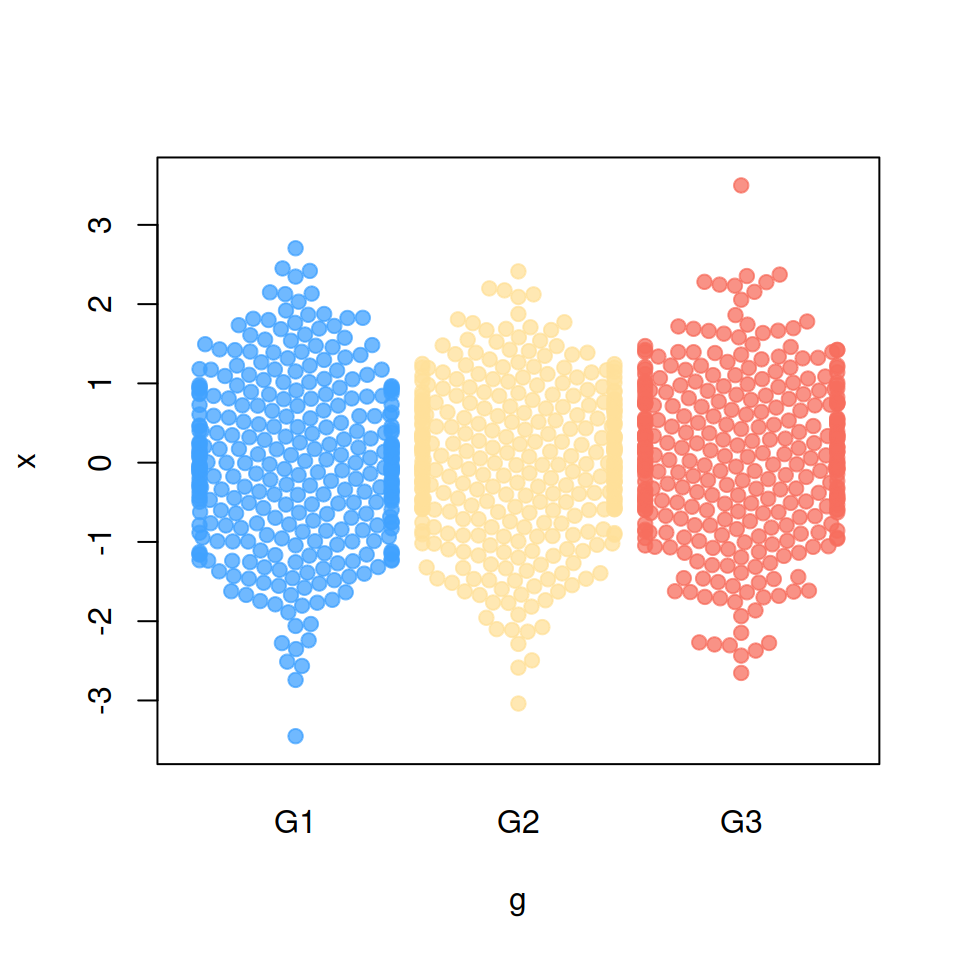
“gutter” method
# install.packages("beeswarm")
library(beeswarm)
# Data generation
set.seed(1995)
x <- rnorm(1000)
g <- sample(c("G1", "G2", "G3"),
size = 1000, replace = TRUE)
# Bee swarm plot by group
beeswarm(x ~ g, pch = 19,
col = c(rgb(0.25, 0.63, 1, 0.75),
rgb(1, 0.88, 0.6, 0.75),
rgb(0.97, 0.43, 0.37, 0.75)),
corral = "gutter")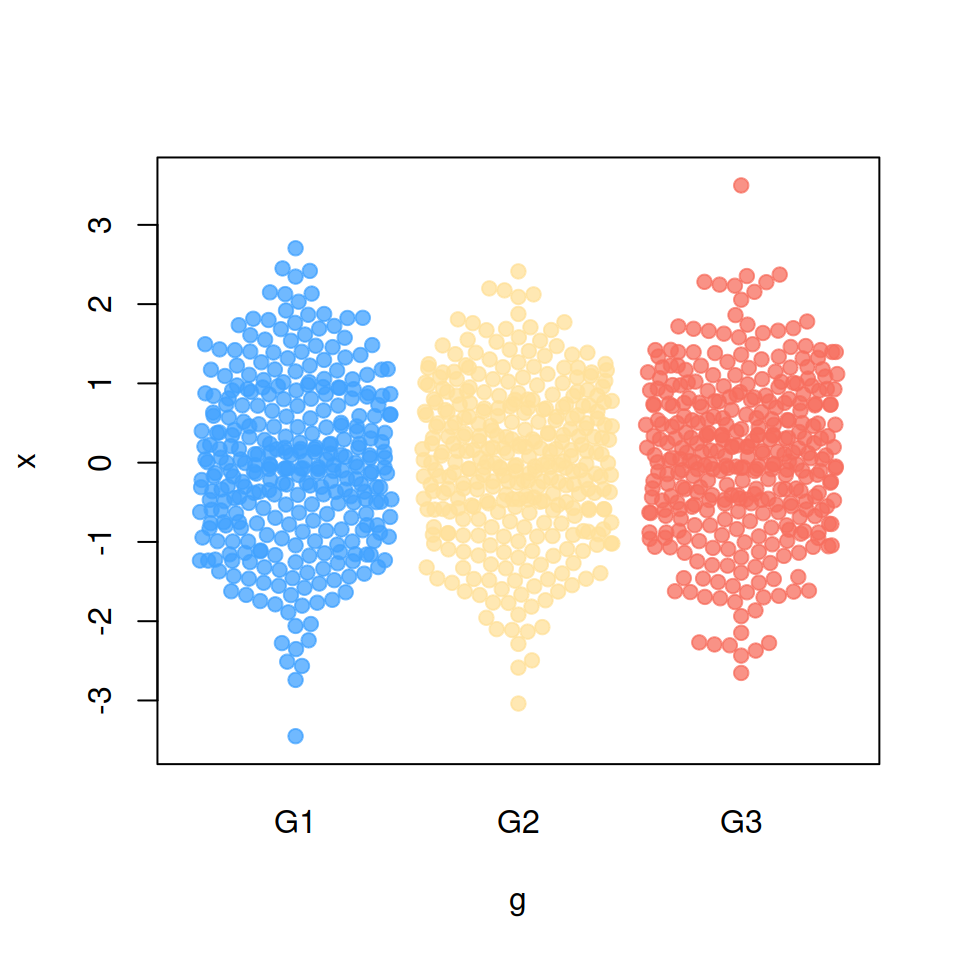
“wrap” method
# install.packages("beeswarm")
library(beeswarm)
# Data generation
set.seed(1995)
x <- rnorm(1000)
g <- sample(c("G1", "G2", "G3"),
size = 1000, replace = TRUE)
# Bee swarm plot by group
beeswarm(x ~ g, pch = 19,
col = c(rgb(0.25, 0.63, 1, 0.75),
rgb(1, 0.88, 0.6, 0.75),
rgb(0.97, 0.43, 0.37, 0.75)),
corral = "wrap")
“random” method
# install.packages("beeswarm")
library(beeswarm)
# Data generation
set.seed(1995)
x <- rnorm(1000)
g <- sample(c("G1", "G2", "G3"),
size = 1000, replace = TRUE)
# Bee swarm plot by group
beeswarm(x ~ g, pch = 19,
col = c(rgb(0.25, 0.63, 1, 0.75),
rgb(1, 0.88, 0.6, 0.75),
rgb(0.97, 0.43, 0.37, 0.75)),
corral = "random")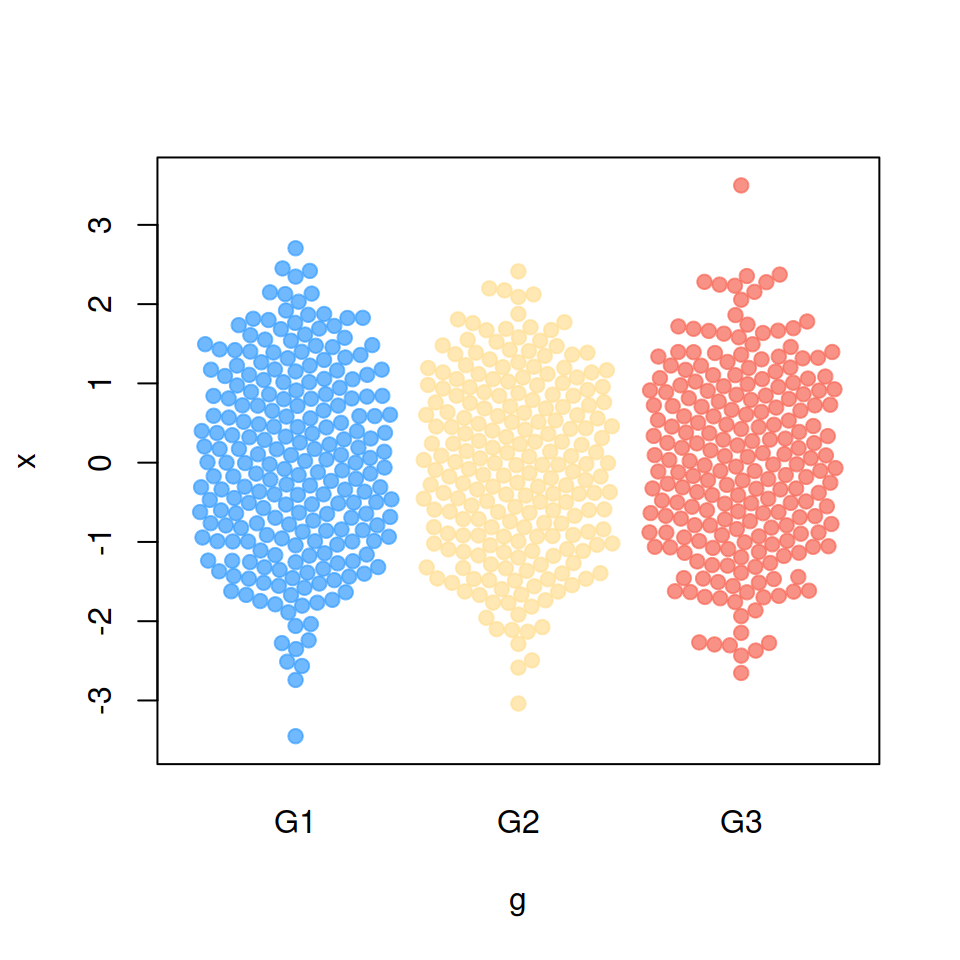
“omit” method
# install.packages("beeswarm")
library(beeswarm)
# Data generation
set.seed(1995)
x <- rnorm(1000)
g <- sample(c("G1", "G2", "G3"),
size = 1000, replace = TRUE)
# Bee swarm plot by group
beeswarm(x ~ g, pch = 19,
col = c(rgb(0.25, 0.63, 1, 0.75),
rgb(1, 0.88, 0.6, 0.75),
rgb(0.97, 0.43, 0.37, 0.75)),
corral = "omit")Bee swarm side
It is possible to display only one side of the bee swarm plot. Set side = -1 to add the points on the left (or downwards).
# install.packages("beeswarm")
library(beeswarm)
# Data generation
set.seed(1995)
x <- rnorm(300)
g <- sample(c("G1", "G2", "G3"),
size = 300, replace = TRUE)
# Left side
beeswarm(x ~ g, pch = 19,
col = c("#3FA0FF", "#FFE099", "#F76D5E"),
side = -1)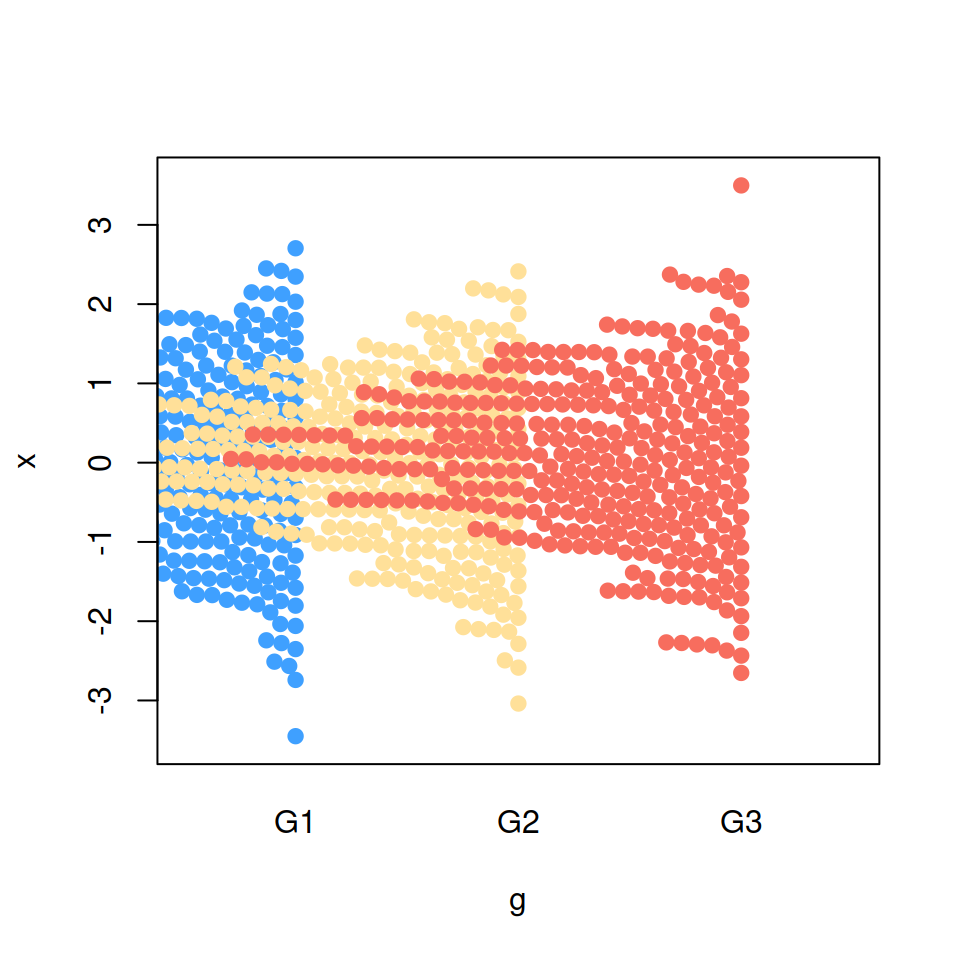
Set side = 1 so the jittering is performed to the right or upwards.
# install.packages("beeswarm")
library(beeswarm)
# Data generation
set.seed(1995)
x <- rnorm(300)
g <- sample(c("G1", "G2", "G3"),
size = 300, replace = TRUE)
# Right side
beeswarm(x ~ g, pch = 19,
col = c("#3FA0FF", "#FFE099", "#F76D5E"),
side = 1)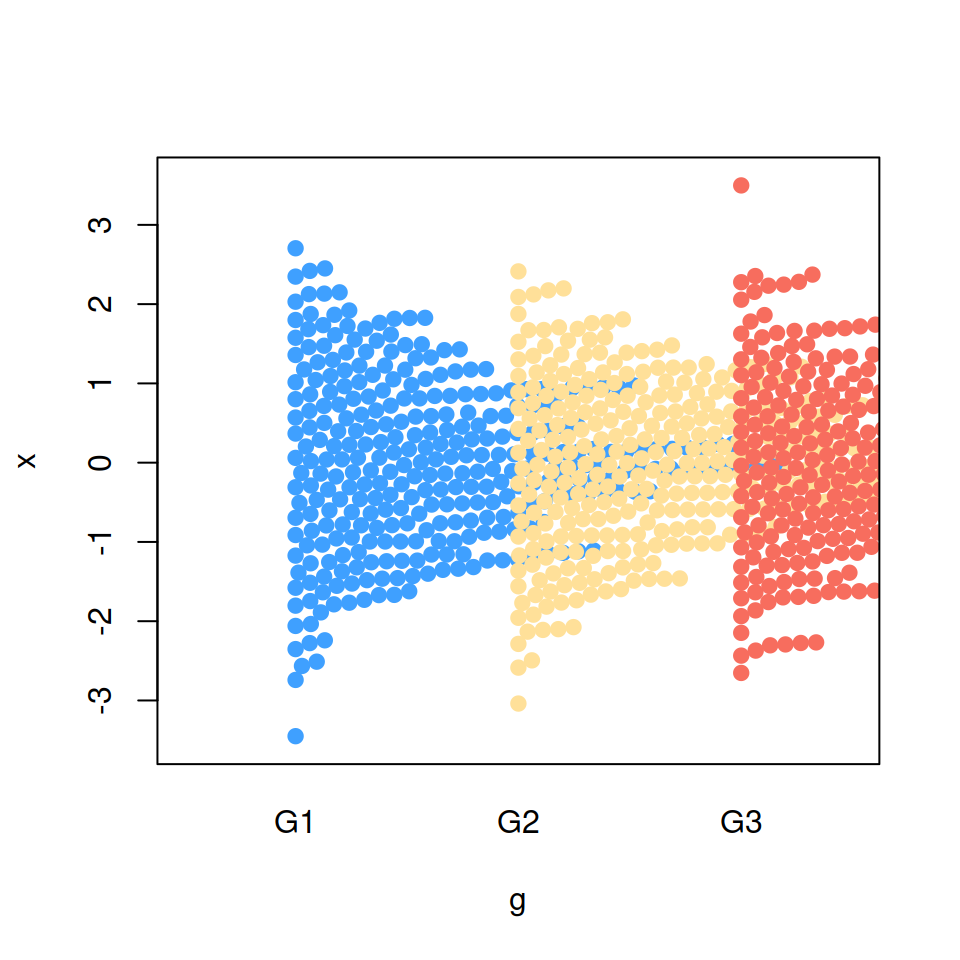
Bee swarm priority
When method = "swarm" you can modify the order used to perform the priority layout. The default method is "ascending" and the other possible values are displayed below. Recall to type ?beeswarm for more information about these methods.
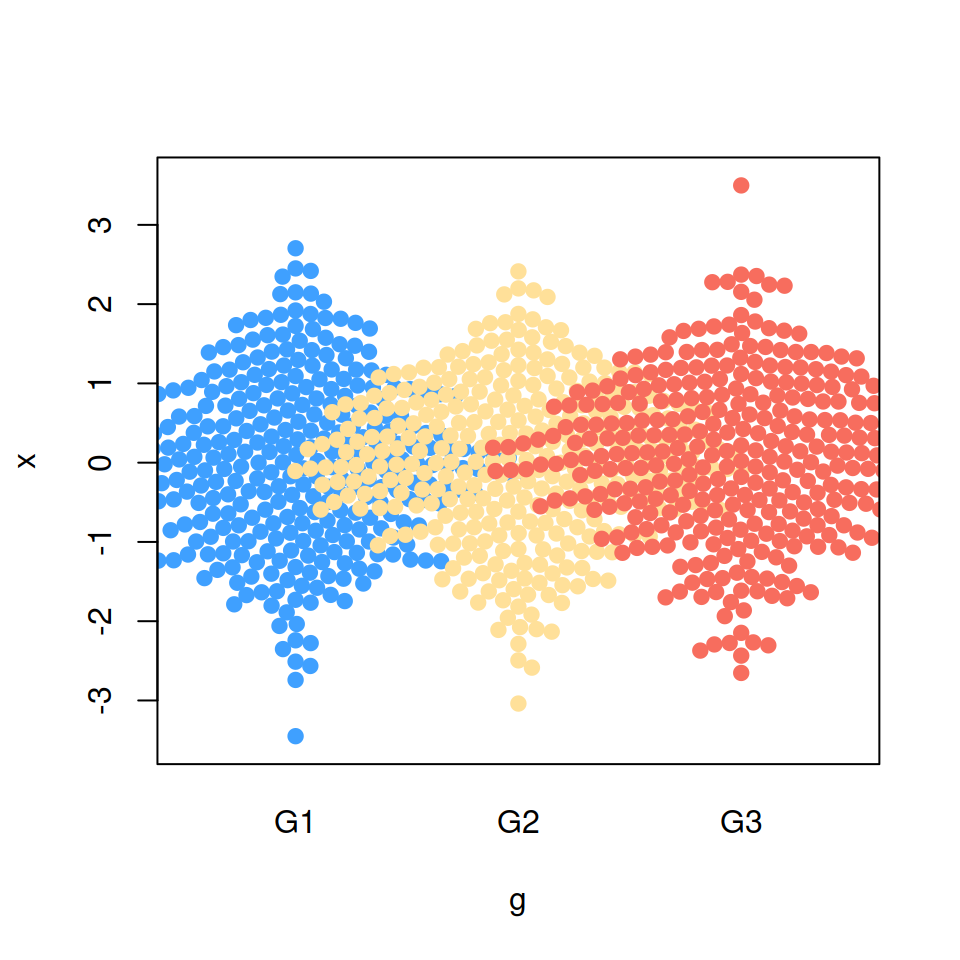
“descending” priority
# install.packages("beeswarm")
library(beeswarm)
# Data generation
set.seed(1995)
x <- rnorm(300)
g <- sample(c("G1", "G2", "G3"),
size = 300, replace = TRUE)
# Bee swarm with descending priority
beeswarm(x ~ g, pch = 19,
col = c("#3FA0FF", "#FFE099", "#F76D5E"),
priority = "descending")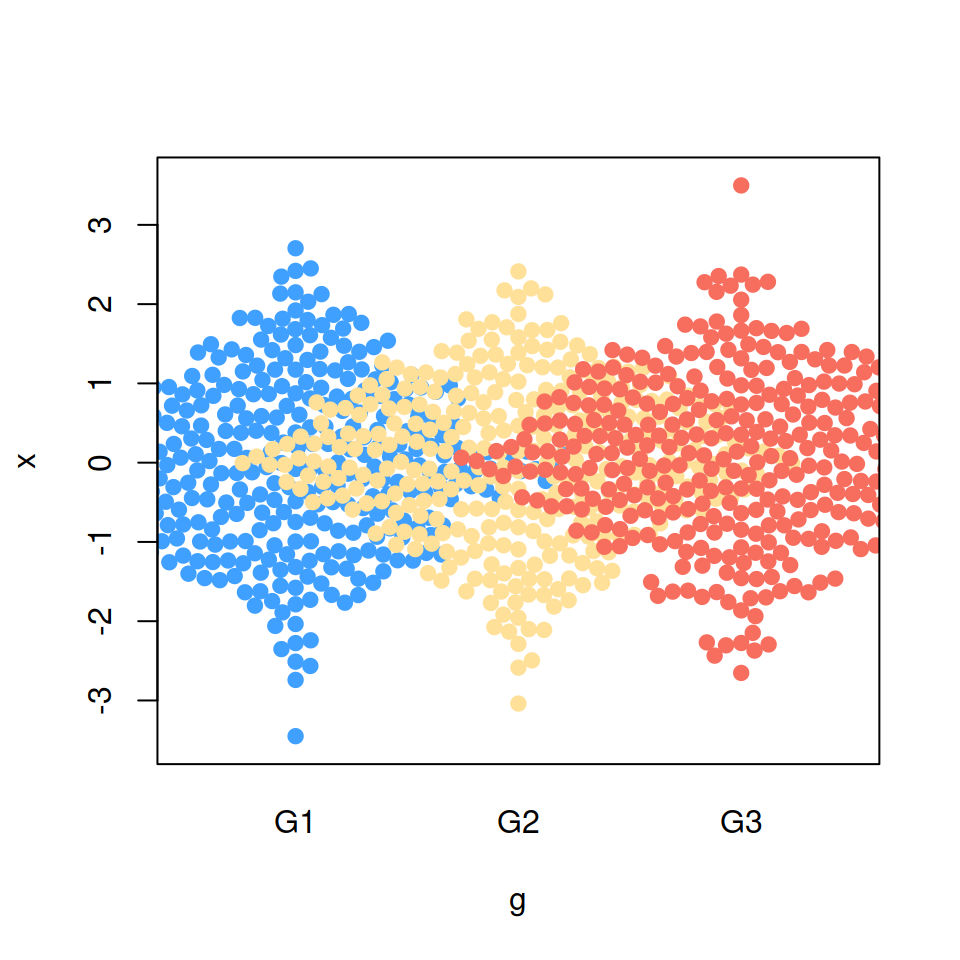
“random” priority
# install.packages("beeswarm")
library(beeswarm)
# Data generation
set.seed(1995)
x <- rnorm(300)
g <- sample(c("G1", "G2", "G3"),
size = 300, replace = TRUE)
# Bee swarm with random priority
beeswarm(x ~ g, pch = 19,
col = c("#3FA0FF", "#FFE099", "#F76D5E"),
priority = "random")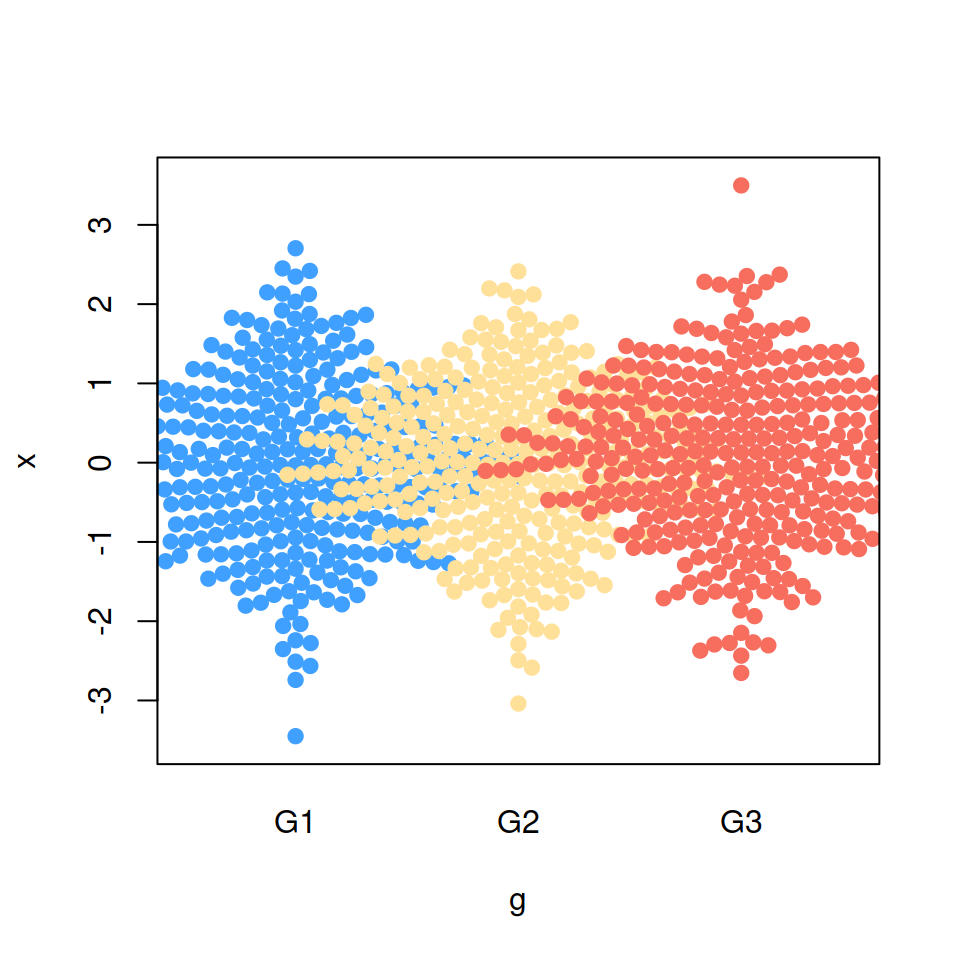
“density” priority
# install.packages("beeswarm")
library(beeswarm)
# Data generation
set.seed(1995)
x <- rnorm(300)
g <- sample(c("G1", "G2", "G3"),
size = 300, replace = TRUE)
# Bee swarm with density priority
beeswarm(x ~ g, pch = 19,
col = c("#3FA0FF", "#FFE099", "#F76D5E"),
priority = "density")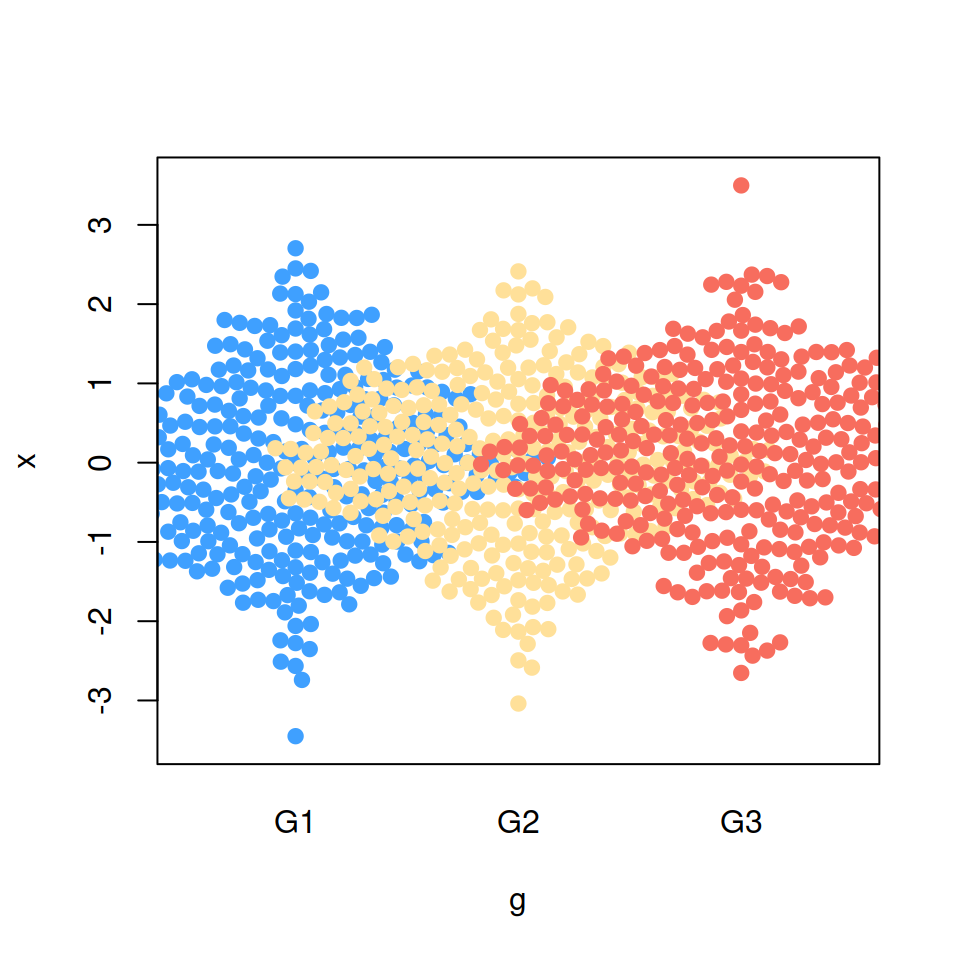
“none” priority
# install.packages("beeswarm")
library(beeswarm)
# Data generation
set.seed(1995)
x <- rnorm(300)
g <- sample(c("G1", "G2", "G3"),
size = 300, replace = TRUE)
# Bee swarm with none priority
beeswarm(x ~ g, pch = 19,
col = c("#3FA0FF", "#FFE099", "#F76D5E"),
priority = "none")
